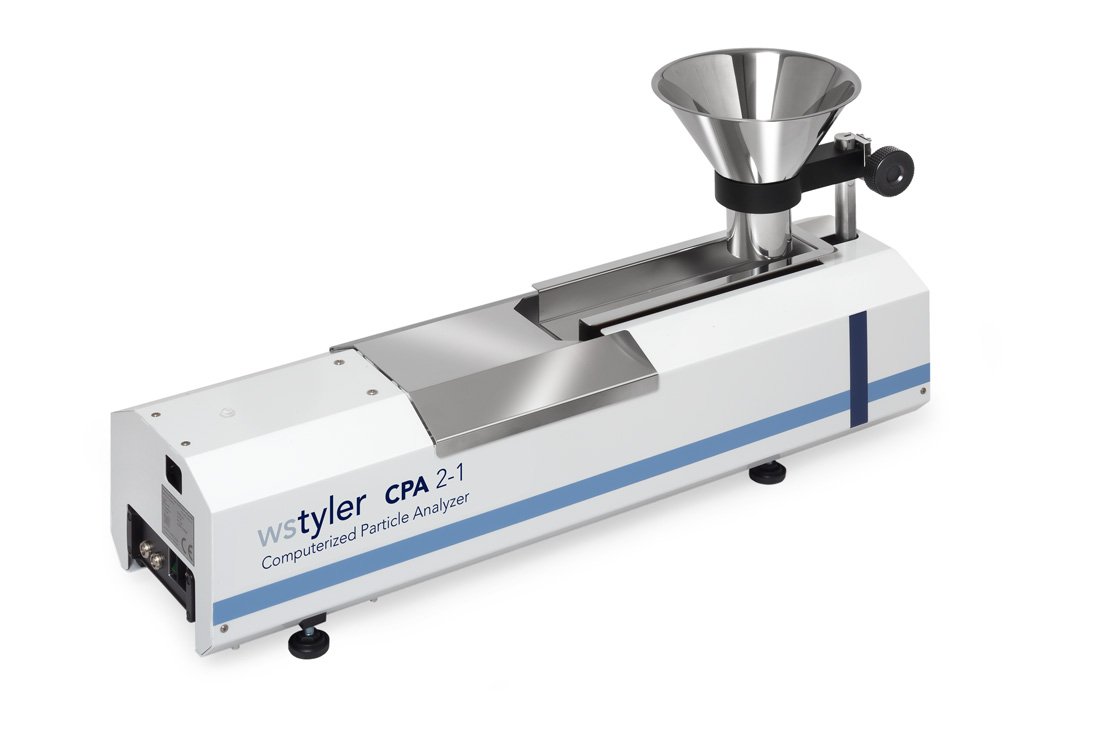What Is the ROI on a Computerized Particle Analyzer (CPA)?
The Computerized Particle Analyzer, also known as a Dynamic Image Analysis system, provides a digital means to determine the particle size and shape of dry, non-agglomerating materials as fine as 10 microns. Best of all, it carries out this process significantly faster than traditional methods.
But is it worth replacing the industry-standard Ro-Tap Sieve Shaker that has been getting the job done for decades?
W.S. Tyler has been a prominent leader in the particle size analysis industry for over 150 years and is here to help build a lab setting that best accomodates the needs and restrictions of your process.
And with that, this article will provide insight into how the Computerized Particle Analyzer streamlines the duties of standard test sieves, further improving your particle analysis operation and, more importantly, saving you money. You will learn:
- How the test sieve analysis and dynamic image analysis processe compare
- How the equipment involved with test sieve analysis and the computerized particle analyzer compare
- How the results gained through test sieve analysis and dynamic image analysis compare
- The average ROI of a Computerized Particle Analyzer
Test Sieve Analysis vs Dynamic Image Analysis
Sieve Shaker
Using a Ro-Tap Sieve Shaker, or any other test sieve shaker, to run your samples can be time-consuming. You first have to assemble your sieve stack, gather and weigh your sample, then begin running it through your sieve stack. The amount of time each test takes depends on the material you’re testing and is determined by either ATSM or ISO standards.
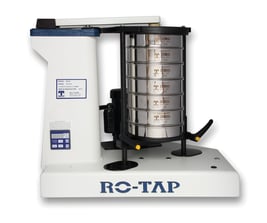
Generally, samples take anywhere from 5 to 25 minutes to run. After the sample has run through the stack of sieves, you will need to collect, weigh, and record the contents of each sieve. After the results have been documented, each sieve should be thoroughly cleaned before the next run.
The total test time will vary, ranging anywhere from 10 to 30 minutes. If you run less than 10 tests a day, this is a sensible solution.
On the other hand, this can be detrimental for companies that run more than this.
For a more in-depth breakdown of test sieve analysis, refer to How To Perform a Test Sieve Analysis (Preparation, Steps, & Tips).
Computerized Particle Analyzer
The Computerized Particle Analyzer does not need a large sample size to produce the desired results. In fact, if you are working with fine materials, such as sand, 20g is an optimal sample size. If you are working with larger materials, the sample needed for testing may be larger than 20g; however, the sample will be noticeably less than a test sieve analysis.
To analyze your material, take your sample, place it in the funnel, raise the funnel 1.5-2 times the height of your largest particle, then run the CPA. Raising the height of the funnel ensures your material is planned, further enhancing the accuracy of your test.
In about 3 minutes or so, you will have your results. The CPA breaks down each virtual sieve and tells you what particles were retained on each one. Best of all, there is practically no clean up needed, allowing you to run another sample in no time.
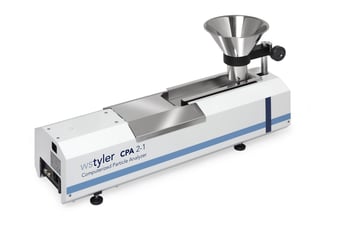 The Computerized Particle Analyzer is ideal for operations that process more than 10 tests a day. If you run less than 10 tests a day, converting your current process may not be necessary.
The Computerized Particle Analyzer is ideal for operations that process more than 10 tests a day. If you run less than 10 tests a day, converting your current process may not be necessary.
Equipment Permanence
Test Sieve
Test sieve replacement is inevitable and needs to happen regularly to stay compliant with industry standards and produce reliable results. The longevity of your test sieves depends heavily on the number of tests you run as well as the type of materials you are testing.
Another critical element to preventing sieve replacement is how often you clean them. To ensure you are yielding accurate
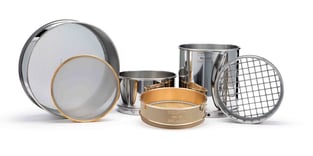
results, it is recommended that you clean your sieves after each use.
It is vital to consider sieve replacement when making a decision, as it can be costly when compared to the minimal maintenance costs of a Computerized Particle Analyzer.
For best maintenance practices, refer to 5 Tips for Maintaining your Test Sieves (Best Practices and Cleaning).
Computerized Particle Analyzer
The Computerized Particle Analyzer rarely has downtime. The only part that endures wear and tear is the conveyor belt, on the CPA Conveyor 2 and CPA Conveyor 4 models, that feeds the material from the funnel to the camera.
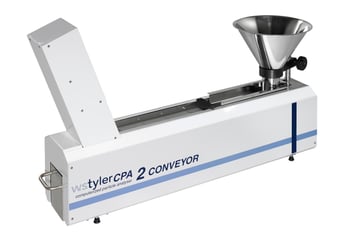
This means your team will spend less time focusing on maintenance and the expenses that come with it, and more time on the task at hand.
Accuracy and Repeatability
Test Sieve
When performing a test sieve analysis, human error can be expected. This is because the process is very hands-on, increasing the chances of skewed results. In some cases, retesting is required, which adds avoidable labor costs.
Computerized Particle Analyzer
The Computerized Particle Analyzer uses computer software (CPA Serv) to cut down on input variables and dramatically lower the chance of error. Accurate results are nearly guaranteed with each test as long as the operator views the results with the proper parameters as determined and set up during installation.
This level of accuracy means your team spends less time retesting and more time on other projects, ultimately saving you money down the road.
What’s the ROI for a Computerized Particle Analyzer
At this point, you’re probably wondering how long it takes for the Computerized Particle Analyzer to pay for itself. What’s the return on investment? Well, the answer is entirely relative to your particular situation.
A traditional test sieve analysis can take up to 30 minutes, which means if you operate five days a week, your sieving process will take 195,000 minutes, or 3,250 hours, throughout the year.
At a modest rate of $20/hr, that’s $65,000 to use test sieves.
With the Computerized Particle Analyzer, those same tests only take three minutes apiece. That means you’re only spending 19,500 minutes, or 325 hours, to run your samples during the year.
That’s a 2,925-hour difference. This means it will only cost $6,500 to run your tests on a CPA, and your skilled laborers will have more time to focus on other projects.
Considering the $60,000 price tag, the return on investment time frame of a Computerized Particle Analyzer is just over 12 months.
Witness the Capabilities of Dynamic Image Analysis Firsthand With a Computerized Particle Analyzer Demo
Test sieves and the Computerized Particle Analyzer are designed to carry out similar particle analysis duties. Selecting the right system relies on the amount of material you and your team are testing daily.
If you have a simple operation that runs less than 10-20 tests a day and does not concentrate on shape analysis, there may not be a need to convert your current Test Sieve setup.
That being said, if you have a hectic operation that runs more than 20 tests a day, switching to a Computerized Particle Analysis or dynamic image analysis system will help save time, allowing your team to work more efficently and generate more revenue.
Now, as Dynamic Image Analysis systems are hefty investments, it is critcal that you fully understand how they fit your process before making a decsion. A great way to gain knowledge about the Computerized Particle Analyzer and all its features is requesting is to request a demo.
Here at W.S. Tyler, we strive to leverage our 150 years of experince to help remove the roadblocks the hinder the efficency of your operation.
To learn how you can request a demo of the Computierzed Particle Analyzer and better understand if it's right for you, read the article below:
About Ronnie Brown
Ronnie is the Content Writer for W.S. Tyler and has four years of experience as a professional writer. He strives to expand his knowledge on all things particle analysis and woven wire mesh to leverage his exceptional writing and graphic design skills, creating a one-of-a-kind experience for customers.

